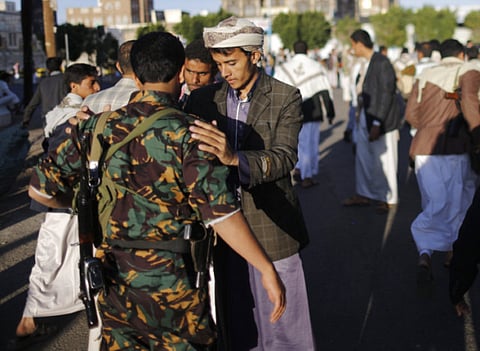Al Houthi rebels: Yemen’s new masters
They have virtual veto power over who becomes the next prime minister and over the make-up of the next government

Sana’a: The capital of Yemen, the Arab world’s poorest and perhaps most chronically unstable nation, has new masters. Al Houthi rebels man checkpoints and roam the streets in pick-ups mounted with anti-aircraft guns. The fighters control almost all state buildings, from the airport and the central bank to the Defence Ministry.
Only a few police officers and soldiers are left on the streets. Rebel fighters have plastered the city with fliers proclaiming their slogan — “Death to America, death to Israel, a curse on the Jews and victory to Islam” — a variation of a popular Iranian slogan often chanted by Shiite militants in Iraq and supporters of Lebanon’s Hezbollah.
While the world has been focused on the fight against Daesh militants in Syria and Iraq, Yemen — located at the southern tip of the Arabian Peninsula — has seen its own sudden, seismic upheaval when Al Houthis overran Sana’a two weeks ago.
Now Al Houthis, who many believe are backed by Iran, are poised to become Yemen’s version of Hezbollah in Lebanon — top power brokers dominating the government and running a virtual state-within-a-state.
Their takeover of the capital also threatens to bring a violent backlash from hardline Sunnis, creating a sectarian battle that would boost Al Qaida’s branch in Yemen. The rallying cry of fighting against Shiite power could turn Yemen into a magnet for Sunni militants from around the region, like Syria and Iraq.
Last week, an Al Qaida suicide bomber rammed an explosives-laden car into a hospital used by Al Houthis in Maarib province, killing one person. The group, known as Al Qaida in the Arabian Peninsula, vowed to fight the rebels and called on other Sunnis to support it.
“You will see your bodies scattered and your heads flying,” Al Qaida said in a statement, addressing Al Houthis.
The president, Abd Rabbo Mansour Hadi, is largely helpless, struggling to form a new government to meet Al Houthis’ demands. Neighbouring Saudi Arabia is worried over a potential pro-Iranian outpost on its border.
Al Houthis are followers of the Zaydi faith that makes up about 30 per cent of the country’s population.
Their advances this year have been startling. They swept south, defeating Sunni tribesmen loyal to the conservative Sunni Islah party, and in July captured Amran province, which borders the capital. They then overran the capital itself on September 21 as the military largely collapsed.
“We are not a group isolated from the rest of the country. We are part of the social fabric,” said Abu Ali Al Hakam, the commander who led the Al Houthi assault on Sana’a. “It is not just Al Houthis who are controlling Sana’a now, its Yemenis from everywhere,” said the diminutive Al Hakam after receiving a hero’s welcome by his fighters.
The scene is further complicated by political rivalries. Hadi’s supporters have long accused Saleh loyalists, who still hold key posts in the military, security forces and government, of undermining Hadi in a bid to return to power.
Saleh and his loyalists in the army are widely believed to have helped Al Houthis by standing aside as the fighters swept into Sana’a.
Ali Al Imad, a senior Al Houthi official, denied there were any “understandings” struck with Saleh’s camp, but he acknowledged that the two sides — bitter foes in six wars between 2004 and 2010 — shared “temporarily mutual interests.”
Hadi appeared caught off-guard. After Amran was captured in late July, Hadi met with politicians who warned him that Al Houthis would move on Sana’a next. “He said he was convinced that Al Houthis will not come near Sana’a,” rights activist Baraa Shiban, who attended the meeting, said.
Tightened grip
A new, UN-brokered accord that was hurriedly signed on the day Sana’a fell to Al Houthis calls for a new government, for all armed factions to put down their arms and for the rebels to leave the capital. But there is little sign that will happen.
“This peace agreement must be implemented, otherwise the prospect of the disintegration of Yemen as we know it will become real,” warned Benomar, who negotiated the accord.
Many doubt Al Houthis have the need or resources to grab more territory. But they have virtual veto power over who becomes the next prime minister and over the make-up of the next government.
And they are locking in their forces’ position in the capital — emulating the model of Iranian-backed Hezbollah, which in Lebanon is the de facto government in predominantly Shiite areas of southern Beirut and in the south and east of the country.
In Sana’a, Al Houthis have tightened their grip on the city’s northern districts where Zaydis are dominant, as well as the nearby international airport. Tanks and armoured vehicles looted from army bases have now been deployed in those areas.
After the fall of Sana’a, Houthis staged a massive victory rally in the city, flying Hezbollah flags and portraits of Iran’s late supreme leader Ayatollah Ruhollah Khomeini.
“It is very clear that Hezbollah is their model. They will never give up control of the airport or the northern districts,” Mohammad Qah’tan, a senior Islah leader, said in a hotel apartment where he has lived since his Sana’a home was stormed by the rebels.
Sign up for the Daily Briefing
Get the latest news and updates straight to your inbox



